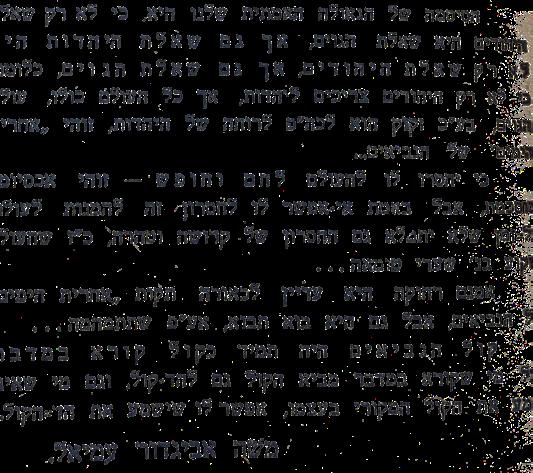
3 minute read
Shining and Sharing Light Inside Out Rabbanit Shani Taragin
Sefer Bereishit begins with the theme of man “calling out” names – the Name of G-d, the names of animals, and even, with great arrogance, the name of man himself. Due to man’s sins, Hashem disperses the nations through seventy different languages, but with the goal of mankind ultimately reuniting and proclaiming together, with a common language, the Name of G-d (Tzefanyah 3:9).
The fixing begins with Avraham calling out G-d’s name, and is continued by Am Yisrael, his chosen descendants, who call out G-d’s name through mitzvot. At the burning bush, Hashem instructs Moshe: “When you take the people out of Egypt, you shall worship G-d on this mountain” (Shemot 3:12), for the goal of freedom is the service of G-d. Ramban explains that redemption comes to fruition when the shechinah reveals itself through the mishkan, a conduit for Bnei Yisrael to call out the name of Hashem. But the ultimate means of the worship of Hashem to the world will come through the mikdash in the Land of Israel, as the nation sang by the Red Sea: “You will bring them and plant them in Your holy mountain, the place for You to dwell in, O L-rd, the mikdash, O L-rd, which Your hands established. The L-rd will reign forever and ever” (Shemot 15:17–18).
Advertisement
The mishkan, a modest and intimate structure, radiated closeness between man and G-d in our early stages of national development. By contrast, the mikdash was a colossal structure broadcasting splendor and majesty to the entire world, the fulfillment of our national redemption that began 480 years earlier with the Exodus. Its construction required foreign artisans and the importing of raw materials. Shlomo HaMelech oversaw this royal project, imposing national taxes and seeking foreign alliances to contribute to this great endeavor. The navi “bookends” its description of the mikdash building project with Shlomo’s marriage to Pharaoh’s daughter, followed by hundreds of weddings to foreign women to forge treaties and expand Israel’s global reach.
Shlomo commissioned ten basins, ten tables and ten menorot , reflecting the increased needs of a growing nation and its many visitors. The Yalkut Shimoni (185) explains that the ten menorot held 70 lights, corresponding to the seventy nations of the world, demonstrating Israel’s influence over neighboring countries. In contrast to the mishkan, where the keruvim faced one another and symbolized the shechinah’s presence among the Jewish people, Shlomo added golden keruvim facing outward, symbolizing our goal of bringing G-d’s name to the broader world. He built magnificent edifices to attract nations to Jerusalem, where they would first appreciate Shlomo’s wisdom and ultimately be drawn to the mikdash and Divine leadership. clouds the peoples; but upon you Hashem will shine, and His glory shall be seen upon you. And nations shall walk by your light, and kings by your shining radiance” (Yishayahu 60:2–3).
But sefer Melachim also warns us of the challenges of windows facing outward and the dangers of marrying foreign women – even if the goal is to bring G-d’s light to the broader world. Foreign influences and conflicting values can easily infiltrate the people of Israel. Even Shlomo HaMelech fell prey to the vices of his wives and concubines. Shining light unto others requires that we respectfully recognize our differences and reject philosophies which undermine our unique history and identity.
Shining light unto others requires that we respectfully recognize our differences and reject philosophies which undermine our unique history and identity.
The windows of the mikdash are described as chalonei shekufim atumim, “transparent sealed openings” (Melachim I 6:4). These windows were unique – “narrow inside, but wide on the outside, to radiate light to the world” (Vayikra Rabbah 31:7). Shlomo believed it was time to fulfill the raison d’etre of the creation of the world – to call out in the name of Hashem through the mikdash Vayechaleihu, “he finished it”, (Melachim I 6:14), completing the process of Vayechulu (Bereishit 2:1), of Divine creation.
During his prayer inaugurating the mikdash , Shlomo uses a term from Shirat HaYam, machon leshivtecha olamim, “a place where You may dwell forever”, four times – declaring the culmination of Jewish and world history, as G-d’s immanence was now clear for all nations to see! “For darkness shall cover the earth, and thick
Today, we are once again living in a time of incredible opportunity, when the miracle of modern Israel and the restoration of the Jewish people allow us to share G-d’s light with the world. Israel is once again a paradigm of intellectual, technological, economic, social and architectural prestige. This time, however, we must attribute our successes to Hashem and never lose sight of our goal of calling out in His name. As we prepare for the restoration of a machon leshivtecha olamim, a mikdash that will eternally bring G-d’s light to the world, may we merit to share our light with others – without diminishing our own.
Rabbanit
Shani Taragin is
Educational Director of
Mizrachi and
the Director of
the Mizrachi-TVA Lapidot Educators’ Program. Join Rabbanit Shani Taragin at the Weekend of Inspiration UK, 11th – 14th May.
Join me at the World Orthodox Israel Congress orthodoxisraelcongress.org Est. 1902







